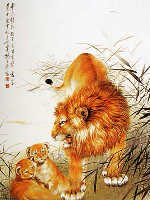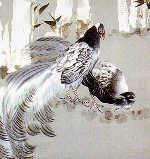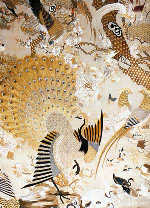Snowed In
Another week has gone by and it’s another week of not being able to do embroidery. It seems like everything worked against me this week haha. This week I planned to work on my piece all weekend, as I usually do, but since I don’t have a printer I asked my mom to print off the pattern for me at her work. She accidentally left it there, which was no big deal since I could go grab it on Sunday, except for the biggest blizzard ever decided to roll into town and swiftly ended my plans. This also would have been salvageable except I had no power and no embroidery needles. So here we are on another brilliant Tuesday, and I have yet to start my DMC piece. Since I didn’t get any actual embroidering done, I decided to do some research on embroidery and learn more about the craft.
The History of Embroidery
Embroidery is an ancient art form that has been found around the world. Embroidery is believed to have originated in China and the Middle East. Ancient Chinese embroidered pieces have been found from as early as 600 CE and embroidery has been found in the tombs of Egyptian pharaohs. Depictions of embroidery filled the drawings of the Greeks and Egyptians. These stunning hand-crafted pieces were not only an art form but a means of storytelling. They were also used to flaunt wealth and status, and used in clothing, religious, and household items. If you’d like to hear more about what started embroidery I highly recommend this video!
Embroidery in China




The production of silk in China gave birth to the art form of embroidery. Once access to such fabrics and threads became available, it was inevitable that people began to explore its capabilities. Embroidery was done primarily by females, and it was a way for the wealthy to show off their wealth. In the beginning, very few common people had access to embroidery as it was very expensive, but eventually, this would change. Soon embroidery began to be used for religion and new techniques allowed portraits to be created. In China, there are 4 famous embroideries. These are known as Xiang embroidery, Shu embroidery, Yue embroidery, and Su embroidery. Each type of embroidery originates from unique locations and circumstances. They each have their own techniques, materials, and style. Su embroidery is over 3000 years old, and in 1950 the government developed research centers and training specifically for Su embroidery.
Embroidery in India
In India, embroidery has many different styles, techniques, and purposes. The development of techniques varied from place to place. Some techniques use thick fabrics and simple threads and some techniques use rich colourful fabrics as well as incorporating beads and other appliqués. Each style uses different stitches, needles, fabrics, and threads. Similarly, it was used as a status of wealth. There are so many different techniques but some include Chikan embroidery, Banjara embroidery, Kantha embroidery, and Shisha embroidery. Chikan embroidery began with white embroidery on white fabrics that depicted floral designs. Banjara embroidery was created by the nomadic tribes of Banjara and is typically brightly coloured embroidery done on equally colourful fabrics. Kantha embroidery is stitched on cloth and gives the fabric a wrinkled effect. It usually depicts florals, animals, and geometric patterns. Shisha embroidery is a technique that incorporates mirrors into the design, giving it a unique appearance.




Embroidery in Europe
In Europe as early as the Middle Ages, professional companies existed dedicated to embroidery. The church was one of the biggest consumers of embroidery and almost all textiles involved in the liturgy were embellished with embroidery. The nobility were also major consumers of embroidery, hiring specific people just to embroider for them. Embroidery became an essential skill for women, demonstrating if they would be good wives or not. Samplers were developed specifically for women to practice their skills and techniques, and books were written describing the process of embroidery. Embroidery was done on many surfaces and was sued as decoration and also to depict stories
Sources:
https://www.metmuseum.org/toah/hd/txt_e/hd_txt_e.htm
https://www.yourlibaas.com/blogs/fashion/10-traditional-embroideries-of-india
http://en.chinaculture.org/library/2008-01/22/content_45156.htm
5 thoughts on “Snowed In”
Way to be productive this week! I completely understand how a week can get away on you and plans have to change, but you totally rolled with it and took a great direction with your learning. I am in awe at the intricacy of embroidery through the historical journey you just took me on. Such beautiful pieces!
Hey Ava, sorry to hear things didn’t work in your favor this week, but I am also happy to see that with all of the things that went wrong, you worked with the best you had and were still able to create a wonderful blog post. Thanks for sharing all of the research that you did regarding embroidery, your post is very informative!
Despite of everything you did a great job with this weeks post. And I love jackets with kantha/kanta embroidery, its quite famous in India.
You did an incredible job this week, despite the challenges! I loved the deep dive into embroidery—so much rich history and craftsmanship. The way you highlighted its evolution was captivating. Kantha embroidery, in particular, is a personal favorite, and it’s awesome to see it getting the spotlight. Keep it up!
Great job on this week’s post! Despite the setbacks, you managed to produce something truly remarkable. I loved how you explored the history of embroidery—it’s so fascinating to see how it has evolved over time. The focus on Kantha embroidery was a wonderful touch, and it’s always nice to see this beautiful art form being recognized. Keep up the amazing work!